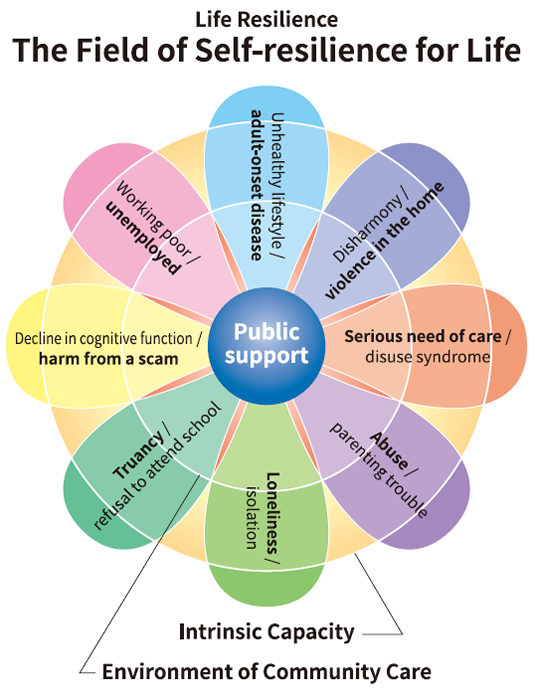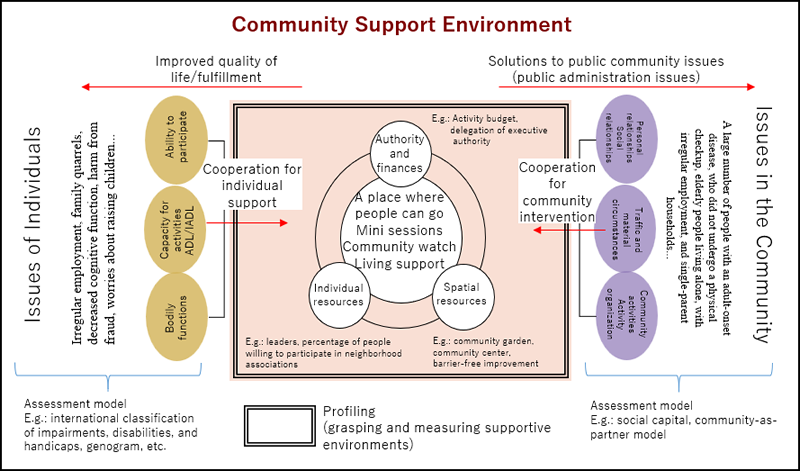Development of a Community Support Environment Model for the Cultivation of the Field of Life Resilience

Project Overview
- Two steps are important during this period of declining birthrate with our aging population, declining growth, and shortage of human resources: 1) early intervention (preventive intervention) before the progression of problems; and 2) the provision of assistance to draw out one’s zest for life (empowerment). However, these steps are limited by the public assistance systems available. For example, there is assistance designed to elicit cooperation with a community support environment where residents feel at ease, such as self-help groups like family meetings, the Kodomo Shokudo Project (the project that provides meals to children), and salon targeting an older audience.
- This type of community support environment has several issues pertaining to its components, such as human resources (the aging of leaders and a decline in participants in neighborhood associations) and spatial resources (the decrease and aging of facilities such as community centers). For example, we do not know if a community’s social capital can be increased, even if the situation is assessed from the outside.
- As basic research to establish the field of life resilience, it is important to develop a model that improves and enhances a community’s support environment by integrating fields through the implementation of empowerment.
- This project will develop a model to improve, enhance, and assess a community’s support environment. We will present a hypothetical model with the following three points configured on an axis. A: Assessment of individual and community issues (especially indexes and baselines related to support environments); B: Discovery of a pattern for solutions to the issues of the social environment and the individual/community; and C: Changes (increases and decreases) in the components of existing support environments.
Overall Picture of the Study

Study Plan
- PD/subcommittee meetings during academic conferences of existing academic societies: We will call for participants for the planning of mini-sessions and panel discussions for the youth initiative during the annual conferences, etc., for each academic society. We will raise questions in the existing academic societies, as well as with the different researchers on the teams for this study, and will receive advice on our position in the individual field and how to advance the field of life resilience.
- Site visits: As part of an area-specific training camp for the previously mentioned field, we will visit the field sites of various studies and evaluate, on site, what kind of assessments they are conducting, whether there are techniques to facilitate cooperation, and what kind of intervention is required. We will then use this information to strengthen the framework of this study field.
- Regular meetings and area-specific training camps: In addition to regular meetings with the principal researchers, researchers comprising the field, practitioners from each field, central players, and members of the advisory board will gather twice a year for a two-day, one-night study-area-specific training camp. We will hear about problems and receive progress reports on the various studies from the advisory board, create teams comprised of different researchers in specialized areas, and examine assessment methods and other matters from diverse angles.
Study Details
- The life resilience field contemplates two approaches for intervention in a community support environment. The first is an approach from the individual task groups—there will be research from the disability and chronic disease group (lead: Takahashi), and the voluntarily appointed guardian and close-following support group (lead: Saisho). The other is an approach from a community task group from the viewpoint of public health—researchers from the community management group (lead: Kimata) in the fields of public health pedagogy, and municipal planning are proceeding with their studies.
- We are consolidating the knowledge gained from the study results from A: Assessment of individual and community issues (especially indexes and baselines related to support environments); B: Discovery of a pattern for solutions to the issues of the social environment and the individual/community; and C: Changes (increases and decreases) in the components of the existing support environments, and are developing a model for improving, enhancing, and assessing community support environments based on the results of the practical studies from each planning study.
- The various groups will implement the following studies:
- How is a community support environment assessed, using the assessment methods unique to each planning study? In addition, could these be performed for every index and baseline?
- For solutions to individual and community issues, will we get an array of outcomes (improvements in the quality of life, solutions to community issues, etc.) if we use a support environment in an array of communities?
- How do the components that constitute a community support environment (authority and finances, human resources, spatial resources) change through intervention B? Why do they change? In those cases, will the indexes and baselines shown in A change? If they do not change, is it necessary for other indexes and baselines to change?
